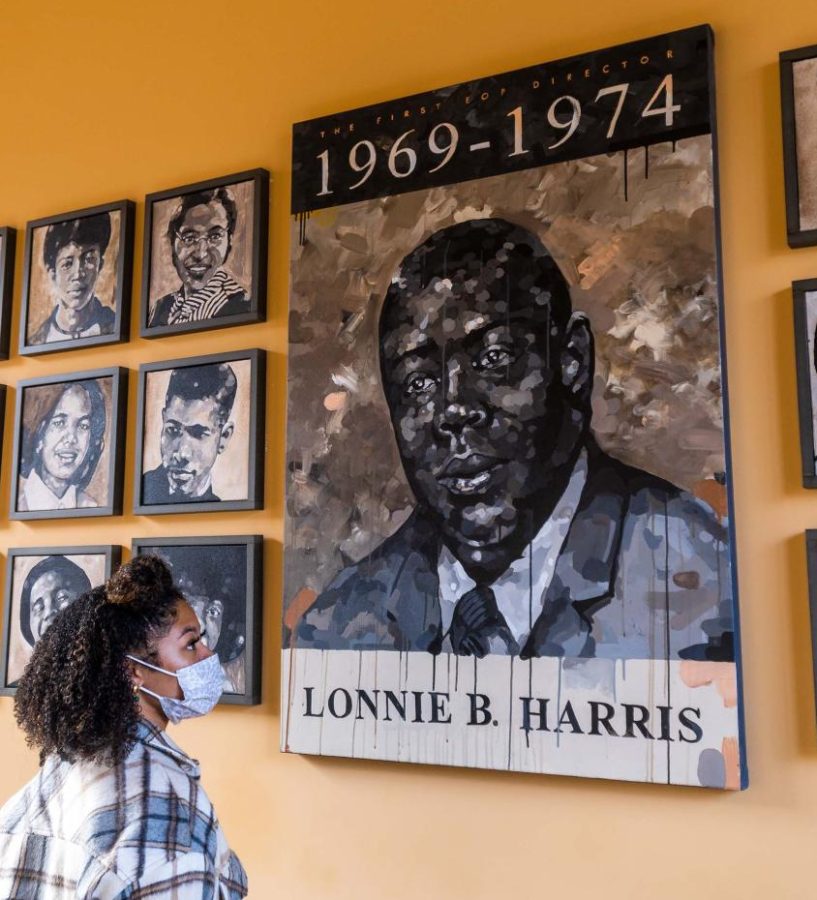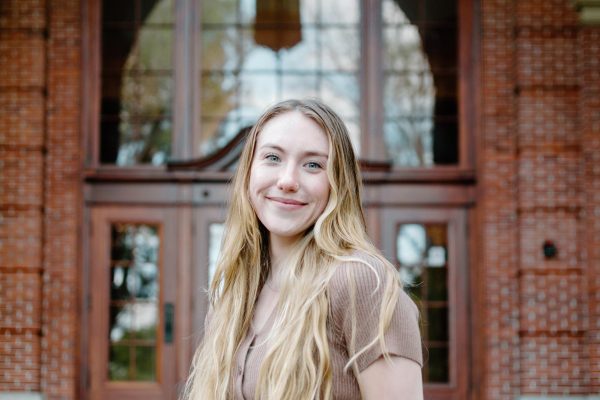OSU Black history is ‘365 days a year’
Second-year public health major Sydney Griswold basks in the history of Black excellence icons in the Lonnie B. Harris Black Cultural Center on Jan. 10. According to Griswold, Black history shouldn’t be limited only to the month of February.
February 7, 2022
For decades, Black Oregon State University community members have fought the university’s racist roots by challenging norms and demanding institutional aid, but this continued effort also requires outside support.
While the state of Oregon does not have an inclusive history—with three Black Exclusionary Laws written into the state’s constitution to discourage Black people from settling in Oregon—Oregon State University, known as Oregon Agricultural College until 1937, also has a racist history.
In the early 1920s and 30s, a small number of Black, multiracial or biracial students in Oregon could avoid getting assaulted or experiencing prejudice more successfully when they were seen as white-passing. Palmer Patton, who in 2020 was recognized as the earliest identified Black OSU graduate, graduated from OAC in 1918 and identified as white at times, though Patton was most likely biracial.
However, there were other Black students who attended the university around the same time and did not pass as white, such as Carrie Halsell, the earliest identified Black female OSU graduate in 1926, and William Tebeau, the former-earliest identified Black male graduate in 1948. Today, two residence halls on campus honor their achievements by bearing the same name.
Terrance Harris, director of the Lonnie B. Harris Black Cultural Center, said about 50 years later, in the 1960s and 70s, about 50 more Black students came to OSU, which Harris said is a sign of how welcoming the university was at the time.
As representation grew on campus throughout the 1960s and 70s, more change on campus began. New institutional offices were formed, such as the Equal Opportunities Program, which was designed to retain and recruit underrepresented students in higher education, as well as the Ujima Education Records Office, which was designed specifically to support Black students, and operated from 1995 to 2013.
In 1969, OSU’s Black Student Union held a historic walkout, one of a few in the campus’s history, in response to rules that forced Fred Milton, a Black football player, to remove his natural hair or else be kicked off the team and lose his scholarship.
The walkout gave rise to racist threats across campus but also inspired positive changes. Students began a limited-run newspaper named The Scab Sheet, to address the concerns of Black students and other students of color. Though Milton and many other Black students eventually transferred to other universities, the walkout led to proposals for more supportive programming and, in 1975, a Black cultural center.
Today, a mural in the BCC depicts this walkout, which Black Student Union President Inez Mbousya describes as one of the most impactful historical events on campus.
“Oregon is known to be a predominantly white state; seeing that, in that walkout, there was more than just other Black students supporting that student definitely made an impact on why that event stood out to me,” Mbousya said.
The BCC was named after the first director of the Equal Opportunities Program—Lonnie B. Harris—who worked to increase the retention and recruitment of Black students at the university.
While the center began as a house on the north end of campus, students and organizations worked to develop programming to build community in the face of discriminatory actions in the area.
“Before the house, there was nothing, and when there was nothing, there was no program,” Harris said. “They were really just trying to get a space at that point.”
In 2015, the current BCC replaced the house to become a cultural center where programming and community have a designated space to grow on campus.
OSU community organizations like the BCC and BSU have created signature programs, such as the fall Black Connect event, pre-Kwanzaa celebration, Soul Food Days, Black Excellence celebration, Black History Month events and a Juneteenth block party to close off the academic year.
“[There] haven’t ever been this many [programs] before, each group has done something different,” Harris said.
According to Harris, it is important to look at OSU history and see what the institution is doing to create a more positive outlook for everyone who is part of the African diaspora that attends the university.
After all, without people to support it, a space is just a space, Harris said.
“We’ve had crosses burned in the yard of the BCC… Black folks getting peed on, somebody having a Confederate flag across the street,” Harris said. “You still have these things that affect a person’s history, affect a person’s ability to proceed at this institution, beyond just events. The purpose of the events is to educate and enlighten and not think of something negative but to honor that.”
According to Regan Le, the acting director of Diversity & Cultural Engagement and acting center director for the Centro Cultural César Chávez, in the past year, new institutions have been established to support and uplift students of color on campus.
These include the Dr. Lawrence Griggs Office of Black and Indigenous Student Success, President’s Commission on the Status of Black Faculty and Staff Affairs, as well as the hiring of Chanale Propst and Ireti (Pamela) DeBato-Cancel, coordinators for Black and African-American Student Mental Health and Wellness through Counseling and Psychological Services.
“Being that the work around diversity, equity and inclusion is dynamic as needs constantly change, it can be a challenge to always meet the ever-changing needs,” Le said. “It’s important that everyone does their part and to do the work in sustainable ways where the burden doesn’t always fall on [Black, Indigenous and people of color] and other historically marginalized folks.”
Though there is greater representation of Black students on campus, Harris and Mbousya said there is always more the university community can do to continue making OSU a more welcoming place.
“It’s something new every year, and we shouldn’t have to wait until February to do it,” Harris said. “Black history is 365 days a year, it’s American history. We are writing history as we are here, every day at this institution doing stuff… It’s about leaving a legacy and leaving your mark.”











































































































